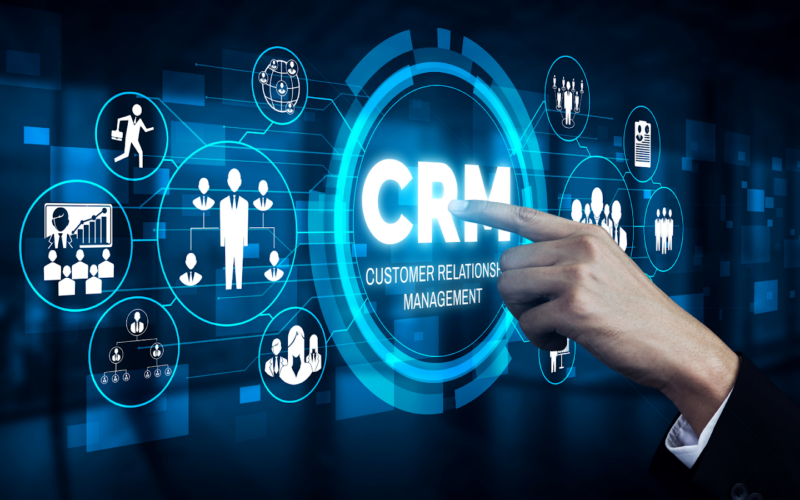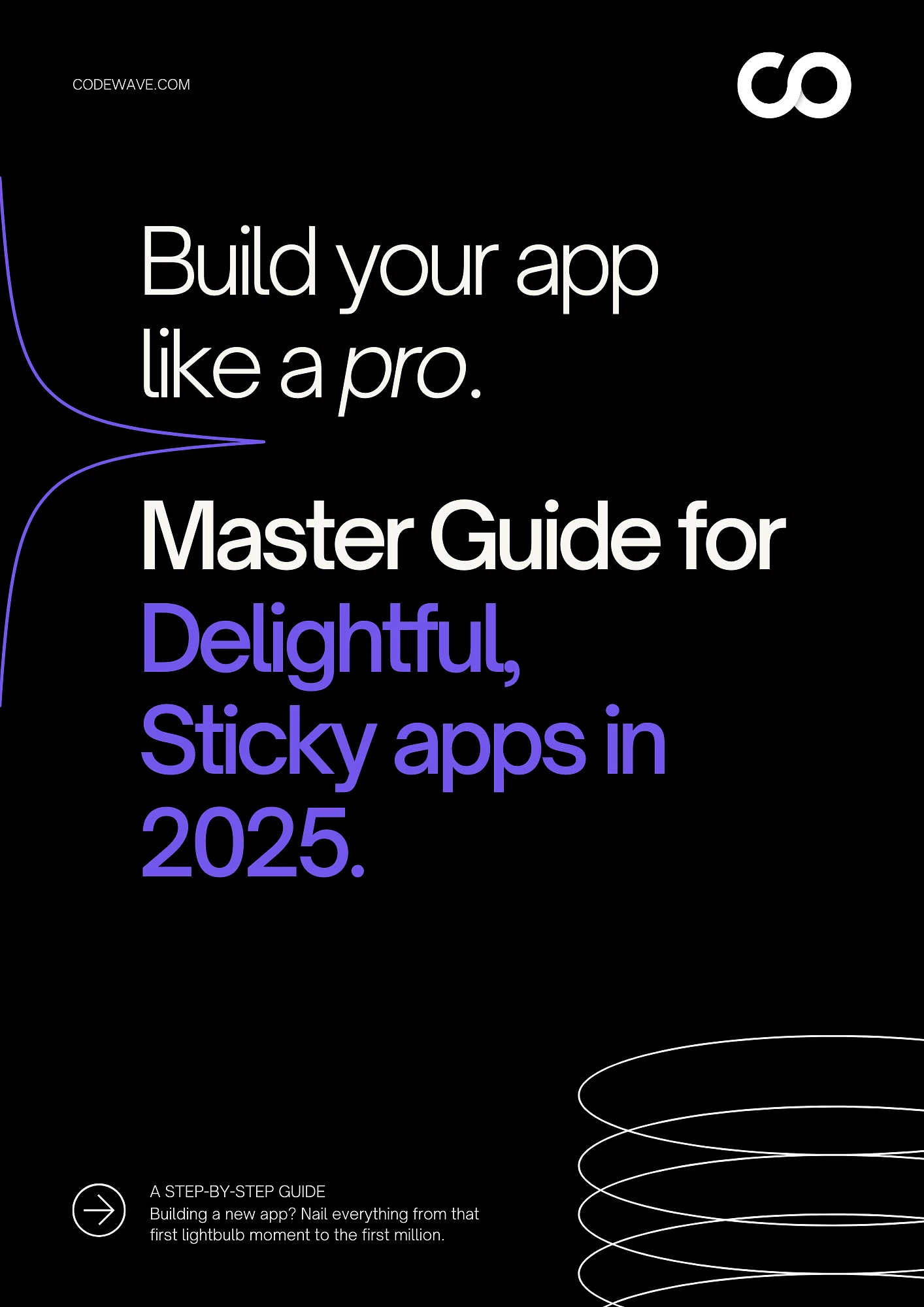Do you feel like your customer data is siloed, you’re manually recording every transaction, and struggling with inaccurate reporting and analytics? We understand that these common issues can cause significant roadblocks for your enterprise, leading to wasted time, missed opportunities, and frustrated teams.
The global customer relationship management (CRM) market is projected to grow from USD 112.91 billion in 2025 to USD 262.74 billion by 2032, showing an impressive growth rate of 12.8% annually. This rapid growth reflects a shift toward more customizable and efficient CRM systems, designed to address specific business challenges.
In this blog, we will guide you through the step-by-step process of designing and developing a custom CRM system tailored to your specific business needs. We’ll explore key features, benefits, common challenges, and real-world examples to help you understand how to build a CRM that meets your unique business needs.
- Custom CRMs offer unmatched flexibility, scaling with your business and adapting to unique workflows.
- Choosing the right CRM depends on business size, complexity, and future growth plans; custom works best for long-term strategies.
- An MVP approach speeds up CRM deployment, focusing on essential features before expanding based on user feedback.
- Emerging CRM trends like AI and blockchain are enhancing personalization, security, and integration capabilities.
- Industries like healthcare and fintech require tailored CRM systems due to strict compliance and data security needs.
What is a CRM?
A Customer Relationship Management (CRM) system is software designed to help businesses manage their interactions with customers, partners, and stakeholders. It centralizes customer data, providing a unified view to streamline communication, enhance customer experience, and drive business growth.
The goal is to increase efficiency, retain customers, and boost profitability. A well-designed CRM enables you to gain valuable insights into customer behavior, preferences, and history, empowering your team to make informed, data-driven decisions. Now that you know what a CRM is, let’s explore the differences between custom and off-the-shelf CRMs.
Custom CRM vs Ready-made CRM: The Differences
When choosing a CRM system, businesses face the critical decision between opting for a custom CRM or a ready-made CRM solution. Both have their own set of benefits. Let’s explore them in detail:
- Custom CRM: A custom CRM is tailored to your unique business needs. It is designed to fit your specific workflows, streamlining operations while providing complete control over data and security.
- Ready-made CRM: A ready-made CRM, on the other hand, is a pre-configured solution that can be quickly implemented. It offers standard features and is designed to meet the needs of many businesses with less flexibility for customization.
Now, let’s explore the key differences between these two options and how they impact your business operations:
| Criteria | Custom CRM | Ready-made CRM |
| Ease of Setup | Requires development before use. | Ready for immediate use. |
| Feature Flexibility | Highly customizable to meet specific business needs. | Limited customization; may include unused features. |
| Scalability | Highly scalable and adaptable to business growth. | Scalability is often tied to pricing plans and feature limits. |
| Data Storage | Configurable based on your needs and preferences. | Limited storage capacity, often predefined. |
| Cost Structure | Higher upfront cost with no extra user fees. | Pay-per-user, resulting in potentially high costs for larger teams. |
| Technical Knowledge | Requires expertise for development and maintenance. | Minimal technical knowledge is needed for implementation. |
| Vendor Maintenance | Requires an in-house team or external contractors for maintenance. | Vendor handles maintenance and updates. |
| Compatibility | Highly adaptable to existing systems. | May face compatibility issues with some systems. |
| Security Control | Full control over data security and compliance. | Limited control over data security and compliance. |
| Long-Term Strategy | Fully aligned with your unique business strategy. | May not be able to align with long-term strategic goals. |
Understanding these key differences enables you to make an informed decision tailored to your unique business needs. Next, we’ll explore when to consider a custom CRM and when to choose an off-the-shelf solution.
When to Use Custom vs. Off-the-shelf CRM Systems
For enterprises, the choice between custom and off-the-shelf CRM often hinges on your unique industry needs, sales workflows and customer management requirements. Here we present some scenarios where you can consider a custom or off-the-shelf CRM system:
When to Use a Custom CRM System
1. You need full alignment with unique business processes
If your business has specific workflows or requirements that off-the-shelf CRMs can’t accommodate, custom CRM systems can be designed to integrate seamlessly with your operations.
Example: A healthcare provider requires a CRM system integrated with patient management software for compliance with HIPAA regulations. This custom CRM ensures streamlined patient care, reduces administrative overhead, and mitigates legal risks, ultimately improving operational efficiency and patient satisfaction.
2. Your business operates at a larger scale or has growing needs
As your business expands and your CRM requirements become more complex, a custom solution can evolve in tandem with your growth.
Example: A retail chain with multiple locations and a need for highly personalized customer management and inventory integration. A custom CRM improves cross-location communication, boosts inventory tracking, and enhances personalized marketing. The result is better customer satisfaction, increased sales, and reduced operational costs.
3. You need advanced features and integrations
Custom CRMs can be designed to support advanced functionalities, such as AI-powered analytics, customer segmentation, and deep integration with proprietary systems.
Example: A fintech company that needs to integrate real-time financial data and advanced reporting tools within its CRM. A tailored CRM empowers data-driven decision-making, enhances predictive analytics for customers, and provides more accurate reports. This leads to higher customer retention, better forecasting, and improved decision-making speed.
4. You require control over security, compliance, and data management
If your company handles sensitive data or must meet strict regulatory standards, a custom CRM offers complete control over data security and privacy.
Example: A bank needs to secure its customer database with customized data encryption and access controls. With a custom solution, the bank can improve its data protection measures, ensure regulatory compliance, and foster trust with customers. This not only minimizes the risk of breaches but also enhances brand reputation and customer loyalty.
Industries that Benefit from Custom CRM Software
Certain industries require more specialized CRM systems due to their complex workflows, stringent regulatory requirements, or high data security needs. Here are some industries that benefit greatly from custom CRM software:
- Fintech: Due to stringent regulatory requirements and the need for secure financial transactions, a custom CRM enables tailored security measures and seamless integration with banking systems.
- Healthcare: HIPAA compliance and the need for secure patient data management make a custom CRM system a necessity. It ensures smooth integration with Electronic Medical Records (EMRs) and simplifies workflow management.
- E-commerce and Retail: Custom CRMs enable e-commerce and retail businesses to integrate customer data with inventory systems, track customer journeys, and refine marketing strategies for enhanced conversion rates.
- Insurance: The insurance industry requires CRMs that manage large volumes of data, ensure regulatory compliance, facilitate claims processing, and streamline policy management. A custom CRM ensures that customer interactions are tracked efficiently and securely.
- Travel: The travel industry needs CRMs to integrate with booking systems, manage customer preferences, and personalize communication. A custom CRM can handle the dynamic nature of bookings, cancellations, and personalized itineraries.
When to Use Off-the-Shelf CRM Systems
Off-the-shelf CRM systems are ready-made solutions that can be quickly deployed, making them suitable for businesses with simpler needs or tighter budgets. Here are situations where an off-the-shelf CRM could be a better choice:
1. You have simple, standardized workflows
If your business has basic customer management needs and straightforward sales processes, off-the-shelf CRMs can handle them efficiently without the need for custom development.
Example: A small marketing agency that needs a simple CRM to track leads and client communications.
2. You need a quick solution with limited customization
Off-the-shelf CRMs come with pre-configured features, allowing you to set up and start using the system immediately, making it an excellent option for businesses on tight timelines.
Example: A small retail business looking to implement a CRM quickly to manage customer information and track sales.
3. You have a limited budget and resources
If your company lacks the technical resources or budget to build and maintain a custom CRM, an off-the-shelf system offers an affordable and effective solution.
Example: A new startup that wants to manage basic customer information without investing heavily in a custom solution.
4. You need basic integration and functionality
If your CRM needs are basic and involve minimal integrations, an off-the-shelf system will suffice and be easier to implement.
Example: A consultancy firm that needs a simple CRM for managing client contacts and scheduling appointments.
Now, let’s explore the different types of CRM systems available for enterprises.
Common Types of CRM Systems for Enterprises
When selecting a CRM system for your enterprise, it’s crucial to understand the different types available. Each type addresses unique business needs and challenges. Here’s a comparison of the three most common CRM types for enterprises:
| Aspect | Operational CRM | Analytical CRM | Collaborative CRM |
| Key Features | – Sales automation- Marketing automation- Service support | – Data analysis- Segmentation- Performance tracking | – Shared customer data- Real-time updates- Cross-department communication |
| Best for | – Streamlining customer-facing processes- Sales, marketing, service teams | – Gaining customer insights- Market trends and forecasting | – Team collaboration on customer accounts- Multi-department communication |
| Benefits for Enterprises | – Reduces manual tasks- Improves workflow efficiency- Boosts sales team productivity | – Enables data-driven decisions- Enhances marketing ROI- Optimizes sales funnels | – Improves team collaboration- Increases customer satisfaction- Aligns departments effectively |
By understanding these CRM types and their unique benefits, you can choose the one that aligns with your enterprise’s goals. Do you want to design your CRM? Here’s a step-by-step guide to developing a successful CRM system.
Step-by-Step Guide to CRM System Design & Development
Developing a custom CRM system is a structured journey that begins with identifying your goals and extends through to deployment. Below is a detailed step-by-step guide that outlines the entire process of CRM system design and development.
Step 1: Define Your CRM Objectives
Before diving into the technical aspects of CRM development, it’s essential first to define clear objectives for your CRM. These objectives will serve as the foundation for the entire development process. Setting clear objectives helps you align your CRM with your strategic goals. It ensures that your CRM becomes a valuable tool, solving key business challenges and driving growth.
What it includes:
- Identify Key Business Needs: What do you want the CRM to achieve? Define clear goals, such as improving sales efficiency, enhancing customer service, or consolidating data.
- Involve Key Stakeholders: Gather input from sales, marketing, customer support, and IT teams. Each team has unique needs that should be incorporated.
- Set Measurable Goals: For instance, aim for a 20% increase in sales efficiency or a 30% reduction in customer service response time by 30%.
- Evaluate CRM Requirements: List the core features needed to meet objectives, such as lead management, contact tracking, or reporting.
- Define Key Performance Indicators (KPIs): KPIs such as customer retention rates, sales conversion rates, and average response time should be clearly defined.
Pro Tip: Regularly revisit and revise your CRM objectives to align with evolving business needs and market conditions.
Example: For a company focusing on lead conversion, the CRM should include tools for lead management, tracking, and real-time follow-ups.
Step 2: Conduct Market Research and Analysis
Conducting thorough market research helps you identify industry trends, gaps in current CRM solutions, and features that your competitors might be overlooking. It ensures that your CRM will be competitive, leveraging current technologies and addressing unmet needs in the market.
What it includes:
- Analyze Competitors: Evaluate CRM solutions used by your competitors. Look at their strengths, weaknesses, and user feedback.
- Assess CRM Features: Identify features that are missing from existing systems or need improvement. For instance, CRM systems with poor mobile compatibility or user experience can be a gap you can fill.
- Stay Updated on Trends: Explore the latest CRM trends such as AI-powered chatbots, predictive analytics, and automation tools that can enhance customer experiences.
- Gather User Insights: Conduct surveys or interviews with potential CRM users within your organization to learn their pain points and requirements.
- Evaluate Case Studies: Look at CRM success stories within your industry. Understand what strategies worked and what didn’t, and apply those insights to your project.
Pro Tip: Gather feedback from all departments early in the research process to avoid creating a siloed system that fails to meet cross-departmental needs.
Example: A competitor might have a CRM with a poor user interface design, which can inspire you to focus on building an intuitive and easy-to-navigate system.
Step 3: Choose the Right Technology Stack
The technology stack includes the tools, languages, and frameworks used to build your CRM, and it needs to support your CRM’s functionality and scalability. The right technology stack ensures that your CRM system is scalable, secure, and easy to maintain, while also enabling smooth integration with other business systems.
What it includes:
- Assess Project Needs: Determine the complexity of your CRM and how many users will be involved. Choose technologies that support your scale.
- Frontend Framework: Decide on a frontend framework like React, Angular, or Vue.js based on your UI needs and user experience goals.
- Backend Framework: Select a backend framework such as Node.js, Python, or Java, ensuring that it can handle large-scale data and transactions securely.
- Database System: Choose a database (MySQL, PostgreSQL, MongoDB) based on your data structure needs. Relational databases work well for structured data, while NoSQL is ideal for unstructured data.
- Consider Integration Capabilities: Your CRM should be able to integrate with tools like email platforms, accounting software, and other business systems.
- Scalability: The tech stack should be flexible and scalable, capable of handling increased traffic or data volume as your business grows.
Pro Tip: Choose a tech stack that offers strong community support and extensive documentation for long-term maintenance and troubleshooting.
Example: If you’re a large enterprise dealing with vast customer data, a relational database like PostgreSQL will provide reliability, while a microservices-based architecture will support scalability.
Step 4: Design a User-Centric Interface
The CRM interface is the first point of interaction for users. A clean, intuitive design not only enhances user adoption but also boosts efficiency across teams. A user-friendly design ensures that your CRM is easy to use, reduces the learning curve, and drives higher productivity.
What it includes:
- Simplicity: Avoid unnecessary complexity. Organize features logically and highlight key actions users need frequently.
- Wireframes and Prototypes: Create wireframes to visualize CRM layout and functionality. Use prototypes to test early concepts with actual users.
- UX Focus: Streamline the user experience. Make common tasks easy to execute and ensure smooth workflows.
- Mobile and Multi-Device Access: Ensure your CRM is mobile-responsive, allowing users to access key features on the go.
- Customization Options: Allow users to tailor their dashboard to their specific roles, making the interface more relevant and efficient.
Pro Tip: Transform your team’s workflow with Codewave’s UX-UI design services. We specialize in crafting intuitive, high-impact interfaces that improve internal CRM usability and boost team productivity. Experience seamless design that drives results at 30% lower costs.
Example: For a sales team, provide a clear and simple interface that displays real-time pipeline status and upcoming tasks.
Step 5: Build an MVP with Core CRM Features
The MVP (Minimum Viable Product) approach enables you to launch the CRM with essential features, gather user feedback, and iterate accordingly. Building an MVP helps you focus on delivering key functionalities first, reducing development time and allowing for faster user feedback and improvements.
What it includes:
- Focus on Core Features: Include essential features such as contact management, lead tracking, sales pipeline, and reporting.
- User Testing: Deploy your MVP to a limited group of users and gather feedback on its usability, functionality, and performance.
- Iterative Development: Continuously enhance the CRM based on user feedback. Prioritize fixes for critical issues, and introduce new features gradually.
- Scalability Considerations: Build with scalability in mind. Ensure the system can handle an increasing number of users and data as your business expands.
Pro Tip: Start with the essentials, including contact management and the sales pipeline, and gather user feedback regularly to inform the next iteration.
Example: Launch an MVP that includes lead management and sales forecasting features to start gathering feedback from sales teams.
Step 6: Plan Smart Integrations
Smart integrations enable your CRM to connect with other systems in your tech ecosystem, improving data flow and reducing silos. Integrating your CRM with other tools enhances collaboration, minimizes manual data entry, and ensures data consistency across departments.
What it includes:
- Assess Current Systems: Identify existing software tools that need to integrate with the CRM (email, ERP, calendars, etc.).
- Use APIs for Seamless Sync: Use APIs to automatically sync data between your CRM and other platforms.
- Integration Priorities: Start with high-priority integrations that will directly impact user efficiency, like syncing with email or sales tools.
- Plan for Scalability: Ensure the integration process can scale with future business needs.
Pro Tip: Consider using third-party integration platforms like Zapier for quick and easy integrations with popular tools.
Example: If your CRM integrates with marketing automation tools, it will allow for smoother lead nurturing and segmentation.
Step 7: Test and Iterate
Testing ensures that your CRM functions as expected and meets the needs of your users. It allows you to identify bugs, security vulnerabilities, and usability issues, ensuring that the CRM works efficiently and securely. Regular iterations refine the CRM, improving its performance and usability over time.
What it includes:
- Unit Testing: Test each component for correctness.
- Integration Testing: Verify that different CRM modules work seamlessly together.
- User Acceptance Testing (UAT): Gather feedback from users about the system’s usability and functionality.
- Performance Testing: Test the CRM under heavy load to ensure it can handle large volumes of data.
- Security Testing: Ensure data protection through encryption, access control, and other security measures.
Pro Tip: Continuously test and iterate post-launch to address emerging issues and make ongoing improvements.
Example: Before the full deployment, ensure the CRM can handle multiple users simultaneously without crashing.
Step 8: Deployment and Maintenance
Once your CRM passes testing, it’s time for deployment. Successful deployment and maintenance ensure your CRM continues to function as expected and adapts to changing business demands.
What it includes:
- Data Migration: Ensure the smooth migration of customer data from previous systems, minimizing data loss and corruption.
- Training and Onboarding: Provide thorough training to users to ensure successful adoption.
- Monitor Performance: Continuously monitor the CRM’s performance to identify and fix issues quickly.
- Provide Ongoing Support: Offer support to resolve technical issues and ensure smooth usage.
- Plan for Regular Updates: Keep the CRM up to date with the latest features, security patches, and performance enhancements.
Pro Tip: Set up a feedback loop to continue gathering input from users post-deployment and enhance the CRM over time.
Example: After deployment, monitor how the CRM performs with real data and adjust based on real-time feedback.
Also, read our blog on a Step-by-Step Guide for CRM Software Development from Scratch to learn about the process in detail.
Let’s now dive into the benefits a custom CRM brings to your enterprise.
Benefits of Using a Custom CRM System for Enterprises
As an enterprise, adopting a custom CRM system provides a tailored approach to managing customer relationships, improving business processes, and driving growth. Here’s how custom CRM systems can significantly benefit your enterprise:
- Tailored to Your Business Needs: A custom CRM adapts to your workflows, offering precise features that support your business goals. This ensures that every function, from sales tracking to customer support, aligns with your needs.
- Enhanced Customer Relationships and Retention: Custom CRMs offer in-depth insights into customer behavior, enabling the delivery of personalized experiences. According to recent data, 97% of companies using CRM platforms exceeded their sales goals. A custom CRM helps you achieve similar success by improving customer retention and loyalty.
- Improved Data Management and Accessibility: Centralizing customer data in one place makes it accessible across teams, improving decision-making. Everyone has access to real-time information, which enhances collaboration and reduces errors.
- Automation of Routine Tasks: Automating manual tasks, such as follow-ups, data entry, and lead nurturing, saves valuable time. This enhances efficiency and enables your teams to concentrate on strategic, high-impact activities.
- Better Integration with Existing Systems: Custom CRMs integrate seamlessly with your current software infrastructure, ensuring smooth data flow across departments. This reduces silos, streamlining business operations and boosting productivity.
- Scalability for Growing Businesses: As your enterprise grows, a custom CRM evolves with you. Unlike off-the-shelf tools, custom CRMs can be expanded and enhanced to accommodate new business needs without additional costs.
- Stronger Control Over Data Security and Compliance: Custom CRMs offer complete control over data storage and security. You can align your CRM system with your business’s specific compliance requirements, ensuring confidentiality and protecting sensitive data.
- Streamlined Collaboration Across Teams: With a custom CRM, all teams have access to the same data, promoting improved collaboration. A unified approach to customer service enhances internal communication, thereby improving overall efficiency.
- Better Reporting and Analytics: Custom CRMs offer advanced analytics and reporting tools to track performance effectively. According to recent studies, 58% of enterprises have seen a significant increase in customer retention and loyalty by utilizing customer analytics.
A custom CRM is a vital tool for enterprises seeking to optimize operations, enhance customer engagement, and effectively scale their business.
Want to Boost Your ROI with a Custom CRM System?
At Codewave, we offer CRM consulting and implementation services, creating tailored solutions to meet your unique business needs. Our custom CRM systems have resulted in a 300% increase in lead conversion rates and a 34% boost in team productivity for enterprises like yours.
Get in touch with our experts today to know more.
Next, we’ll discuss the key features and modules your custom CRM should have.
Key Features and Modules to Include in Custom CRM Systems for Enterprises
When developing a custom CRM system, it’s important to go beyond standard features and design a solution that adapts to your specific business processes. Here are the key features you should consider including in your custom CRM system:
- Contact Management: Centralize and organize customers and lead data to streamline communication and targeting. It allows segmentation for better personalization and engagement.
- Sales Pipeline Visualization: Gain insight into the stages of your deals, identify bottlenecks, and forecast sales more accurately. This enables sales teams to monitor progress and refine their strategies.
- Task and Activity Tracking: Ensure all tasks, meetings, and follow-ups are documented and assigned. This improves coordination and ensures the timely execution of business activities.
- Reporting and Analytics: Utilize CRM data for actionable insights. Track sales KPIs, customer behavior, and engagement trends to make smarter, data-driven decisions.
- Role-Based Access Control: Safeguard sensitive information by restricting access based on roles. This is essential for compliance, privacy, and data security, particularly in industries with strict regulations.
Want to build your own custom CRM fast and within budget?
At Codewave, with our custom CRM consulting and implementation services, you can streamline your business operations, boost efficiency, and scale seamlessly. We’ve successfully partnered with 400+ businesses across 15+ industries, tailoring CRMs, architecting advanced scoring models, and optimizing funnel flows to deliver measurable results.
Book a consultation with our experts today!
Let’s examine some best practices to gain a better understanding of the process.
Common Pitfalls & Best Practices in CRM System Design
When designing and implementing a CRM system, it’s crucial to avoid common pitfalls that can hinder adoption and functionality. Below, we explore both pitfalls to avoid and best practices to follow to ensure the success of your CRM project.
Pitfalls to Avoid:
- Confusing Navigation: Complex navigation slows down the workflow. Simplify user paths to help employees quickly find the data they need.
- Pro Tip: Use intuitive layouts and minimize unnecessary clicks. Prioritize user experience.
- Chaotic Forms & Data Entry: Unclear input fields or lengthy forms can cause frustration and errors in data entry.
- Pro Tip: Design clear, concise forms with real-time validation and easy-to-understand labels.
- Ignoring Mobile Compatibility: Many CRM systems are desktop-only, which restricts on-the-go access, especially for remote teams.
- Pro Tip: Ensure your CRM is responsive, adaptable to different screen sizes, and mobile-friendly.
- Lack of Accessibility: Excluding users with disabilities can limit the CRM’s effectiveness for all team members.
- Pro Tip: Implement adjustable fonts, color contrast, and screen readers for a fully accessible experience.
- Outdated Visual Design: An outdated interface can make a CRM feel old and less trustworthy, damaging user engagement.
- Pro Tip: Modernize your CRM’s UI to match current design trends, ensuring it’s intuitive and fresh.
Best Practices to Follow:
- Understand Your Audience: Tailor the CRM system based on in-depth research into your teams’ needs, preferences, and workflows.
- Pro Tip: Conduct user interviews and surveys to understand pain points before designing the system.
- Ensure Scalable Design: Build a CRM that grows with your business, adaptable to future processes and data volume.
- Pro Tip: Select a tech stack that offers scalability, allowing seamless upgrades as your business expands.
- Data Security & Compliance: Strong data protection measures are essential for building trust and ensuring privacy.
- Pro Tip: Use encryption, multi-factor authentication, and regular security audits to safeguard sensitive data.
- Streamline Integration with Existing Tools: Ensure your CRM integrates seamlessly with other tools (email, calendar, ERP) for better workflows.
- Pro Tip: Plan your integrations early, using APIs to ensure smooth data syncing across platforms.
- Continuous User Feedback & Iteration: Regularly gather feedback from users to improve and refine the system over time.
- Pro Tip: Set up periodic retrospectives to review CRM functionality and identify areas for enhancement.
By following these best practices and steering clear of common pitfalls, you can ensure the CRM system effectively supports your enterprise.
Also, read our blog on Advantages and Benefits of Enterprise Application Integration to learn more about them.
Finally, let’s take a look at the emerging trends shaping the future of CRM design.
Build Your Ideal CRM with Codewave’s Expertise
Designing a custom CRM system is a strategic decision that can significantly improve customer relationships and streamline your operations. The right CRM can empower teams to work more efficiently, enhance sales, and optimize marketing efforts, ultimately leading to improved customer satisfaction and better business outcomes.
At Codewave, we help you build scalable, custom CRM solutions tailored to your business needs. With over 400+ successful CRM implementations across 15+ industries, Codewave offers expert CRM consulting and implementation services that drive results. Explore our portfolio to see how we’ve empowered enterprises like yours to maximize CRM potential for growth and efficiency.
Our CRM Services Include:
- CRM Platform Evaluation & Vendor Selection: We help you identify the best CRM platform by evaluating your unique business needs. Our experts analyze your processes and workflows, ensuring we select the most suitable tools, whether it’s Salesforce, HubSpot, or a custom solution. This ensures seamless integration and optimal performance across your business.
- CRM Implementation & System Configuration: Our team configures your CRM system to integrate with your current tools, ensuring smooth workflows and maximizing efficiency. We leverage technologies like APIs and RESTful integrations to connect your CRM with other systems, enhancing functionality and delivering consistent data across departments.
- CRM Strategy Development & Roadmap Design: We collaborate with you to develop a clear CRM strategy that aligns with your business objectives. By using data-driven insights and industry best practices, we ensure that the CRM roadmap is adaptable, helping your business stay agile as it grows. Our strategic approach guarantees that the CRM evolves with your needs.
- Sales & Marketing Process Mapping: We work with your teams to optimize sales and marketing workflows, integrating automated processes where needed. By using tools like HubSpot, Marketo, or Pardot, we ensure that campaigns are streamlined, helping you capture, nurture, and convert leads effectively. This leads to faster sales cycles and higher conversion rates.
- Data Governance & Model Planning: We implement comprehensive data governance strategies, ensuring that your CRM system remains compliant and your data is secure. Our approach involves using encryption, access control, and compliance tools like GDPR-compliant platforms, making sure your business meets industry standards and regulations.
- KPI & Dashboard Planning: Our team designs and develops custom dashboards that provide real-time, actionable insights into business performance. By leveraging data visualization tools such as Tableau and Power BI, we help you track key metrics like lead conversion rates and sales performance, driving smarter decisions and better strategic planning.
- Change Management & CRM Adoption Strategy: We guide your teams through the CRM transition, ensuring smooth onboarding and maximizing adoption. Our consultants use proven change management frameworks and offer role-based training sessions to ensure that employees fully utilize CRM features, ultimately driving productivity and reducing resistance to the new system.
- Customized CRM Consulting Services: We offer tailored CRM solutions that evolve with your business. Whether it’s integrating AI-driven analytics, automating customer touchpoints, or building custom modules, we ensure that your CRM adapts to meet the ever-changing demands of your business, improving customer engagement, operational efficiency, and long-term scalability.
Contact us today to explore how Codewave can help you build your ideal CRM system!
FAQs
1. Why does a good CRM user experience matter?
Ans: A good CRM user experience (UX) ensures seamless navigation, improved user adoption, and greater efficiency. When users find the system intuitive, they can perform tasks faster, leading to better customer interactions and more productive teams.
2. How to choose the right CRM development partner?
Ans: Choosing the right CRM development partner requires evaluating their industry expertise, technical capabilities, and past CRM projects. Look for partners who understand your business needs, have experience with scalable CRM solutions, and can provide ongoing support.
3. What is CRM in design?
Ans: CRM in design refers to designing a customer relationship management system that aligns with your business processes and enhances user experience. It focuses on creating a CRM that efficiently stores, organizes, and uses customer data to improve interactions and decision-making.
4. What are the 4 types of CRM systems?
Ans: The four types of CRM systems are:
- Operational CRM – Focuses on automation of sales, marketing, and service processes.
- Analytical CRM – Uses customer data for analysis to improve decision-making.
- Collaborative CRM – Facilitates communication across departments to improve customer relationships.
- Strategic CRM – Focuses on long-term customer relationships and aligning strategies for growth.
5. What are the 5 phases of CRM?
Ans: The five phases of CRM are:
- Planning – Defining goals, KPIs, and CRM strategy.
- Design – Customizing features and functionality to meet specific business needs.
- Development – Building the CRM system with integrations and configurations.
- Deployment – Rolling out the system across teams with proper training.
- Optimization – Continuously refining the CRM based on feedback and evolving business needs.
Codewave is a UX first design thinking & digital transformation services company, designing & engineering innovative mobile apps, cloud, & edge solutions.







